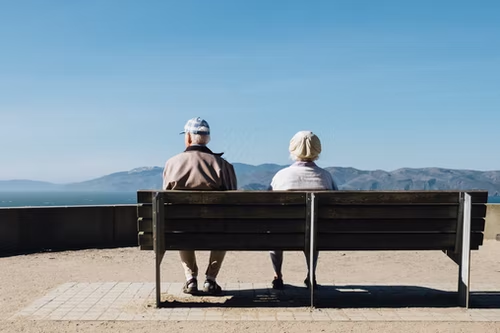Dealing With Grief

The five stages of grief are a popular model for how we experience loss and pain. Here's what you need to know about the process.
Grief is a natural response to losing someone or something that’s important to you. You may feel a variety of emotions, like sadness or loneliness. And you might experience it for a number of different reasons, such as:
- A loved one has died
- You’re going through the ending of a relationship
- You’ve lost your job
- You’re moving away from home or friends
Anyone can grieve, but not everyone does it the same way. So, if you don’t recognize what you’re going through as grief or it doesn’t look like what other people are describing, it doesn’t mean you’re doing it wrong. Your grief is your own and there isn’t one “right way” to do it.
Everyone reacts differently to grief and loss. But there are common stages of grief that many people experience.
The five stages of grief were introduced by Elisabeth Kubler-Ross in her book On Death and Dying, published in 1969. They describe the process grieving people go through when facing a major loss or death.
The stages of grief are:
Denial: “No, this isn't happening.”
When experiencing a traumatic loss, it is common to experience shock and numbness. This denial can last anywhere from a few days to several months. The pain of facing reality can feel overwhelming and we often do what we can to avoid it. Pushing aside difficult feelings may help us temporarily avoid the pain, but eventually these feelings will resurface.
Anger: “Why is this happening? Who is to blame?”
The fact that your life has been turned upside down can make you angry. Maybe you're mad at yourself or someone else for the situation, or perhaps it just seems unfair that life isn't fair.
Bargaining: “Make this not happen, and in return I will ____.”
The second stage of grief is bargaining. During this phase, we try to avoid the reality of our loss by making promises about what we’ll do if only we could be given more time. Sometimes people make bargains with a higher power, others will try to strike deals with a friend or family member in an attempt to take away their pain. If you have experienced a loss, you may have found yourself trying to strike a deal with God. “I’ll be a better person if you just let my loved one live,” or “I’ll go back to church every Sunday if you just give me one more day with them.” Bargaining usually lasts only a few days or even hours, but it can last longer depending on the situation.
Depression: “I'm too sad to do anything.”
You may feel sad or depressed during this time. This stage is also an important part of healing, so don't resist these feelings — try to express them by writing in a journal or talking about them with someone close to you (ideally someone who isn't involved in the situation).
Acceptance: “I'm at peace with what happened.”
This is the final stage of grief, where you finally arrive at a place of acceptance. This does not necessarily mean that you are “over” your loss or have moved on. Rather, you've made peace with your grief and have accepted that life will never be the same. You may feel at least somewhat ready to move on with your life without forgetting the person or thing you lost.
Grief counselors use various models to explain the process of grief and mourning. The most famous grief model was given by Swiss psychiatrist Elisabeth Kübler-Ross in her 1969 book, “On Death and Dying.” In her book, Kübler-Ross described five stages that are often referred to as the “grief cycle” or “grief process.”
The five stages she outlined were denial, anger, bargaining, depression and acceptance. The theory was based on her work with terminally ill patients. Since then, it has been applied to explain how people deal with many types of loss and grief, including pet loss, divorce and breakups. Though this model is still widely used, it is important to understand that no one will experience all of these stages.
The five stages of grief were never meant to help tuck messy emotions into neat packages. They are responses to loss that many people have, but there is not a typical response to loss as there is no typical loss. Our grief is as individual as our lives.
People may experience all of the stages or even none of them at all. Some people who have experienced a significant loss can feel like they are on a roller coaster ride of emotions, going through one stage and then back again.
The stages are not sequential — it's possible to feel one stage strongly and then skip or reverse another stage.
It's normal to feel sad, lonely, or even angry after the death of a loved one. These aren't signs of weakness, they're natural emotions. Here are some other ways to cope with grief:
Acknowledge your feelings. It's OK to feel angry, sad, or depressed about a death. Let yourself cry if you want to. Talk about your feelings with someone you trust. You might also find it helpful to write about your feelings in a journal.
Find support from others who have experienced similar losses. Sharing your experiences with people who are going through or have gone through the same thing can help you heal and learn ways to cope with your grief. You might find support in a bereavement group or from friends and relatives who have lost someone close to them.
Don't make major decisions soon after the loss of a loved one. Emotions can run high for several months after a loss, so try to avoid major decisions right away. Give yourself time to heal before you make any permanent changes in your life such as moving away or changing jobs.
Expect your feelings to come and go in waves. You may feel better for a while and then suddenly become very sad again — sometimes on the anniversary of the death or when you see something that reminds you of it or them.
Talk about it. You may not want to talk about what happened until days or weeks later — and that's OK. But when you're ready to talk, choose someone who will listen without judging you or telling you how you should feel. Talk about your feelings over and over again if you need to. It won't make them go away — but it can help you feel less alone and isolated with your grief.
There are countless ways to deal with grief, and what works for one person might not work for another. It all depends on how you want to overcome it. In the case of death, some people would want to keep their grief internalized, while others want to express it as a way of mourning. Despite the diversity of options, here are five ways that you can deal with your grief that can help you overcome it—or at least help you through it.





